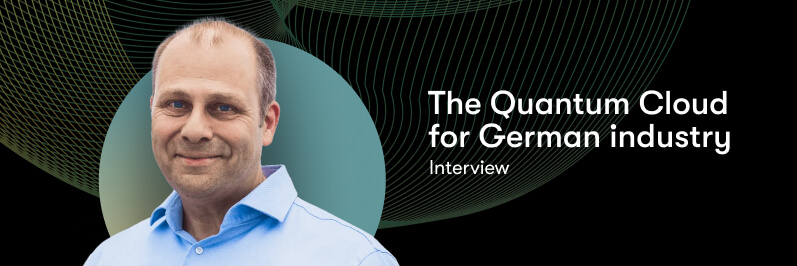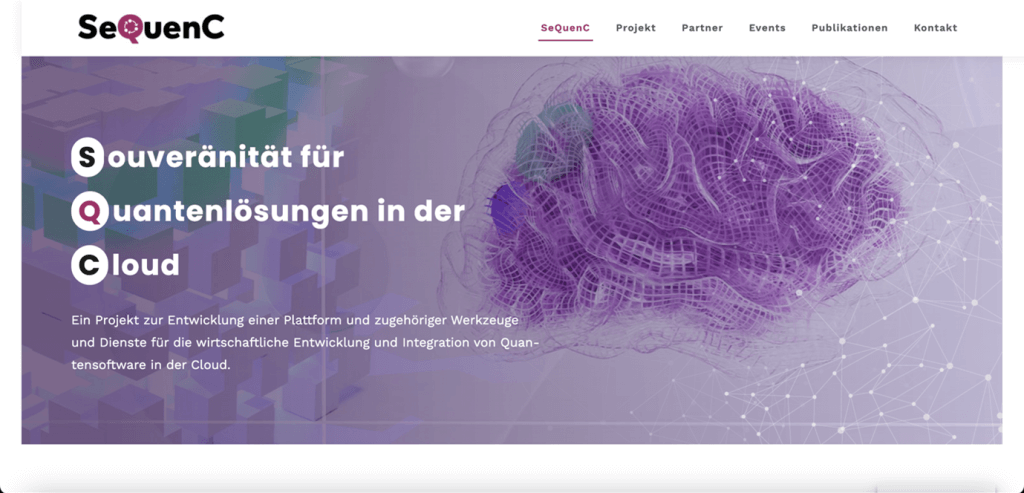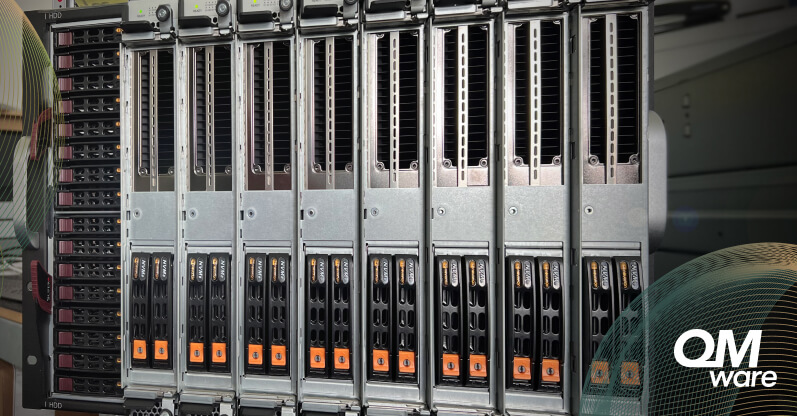The Quantum Cloud for German industry
An interview with Rainer Straeter, Head of Technology Office and Digital Ecosystems at IONOS

An interview with Rainer Straeter, Head of Technology Office and Digital Ecosystems at IONOS
Quantum cloud computing is attracting more and more attention, even in the traditional IT sector. IONOS got involved with the new technology at a very early stage. How did this come about?
The initial impetus came from the SeQuenC research project, which aims to set up a quantum cloud for German industry. The project partners already had a great deal of experience in this area. This made it easier for us to enter the field of quantum computing without a great deal of training.
The second point is, of course, our long-term customer focus and the strategic orientation of our product portfolio. Quantum computing has significant advantages in many use cases compared to conventional technologies.
The third impulse was the launch of ChatGPT at the end of 2022, which sent a shockwave through the industry. Too many colleagues were surprised by the impact of the AI tool, even though some players had already been working on their own language models for some time. I assume that quantum computing will be the “next big thing”. We should be better prepared for this.
Before we talk more about customer benefits and use cases, I’m interested in your personal approach to the quantum cloud. What was the spark that got you excited about the topic?
For one thing, we at IONOS are naturally a little bit in love with technology. Quantum is now overturning everything we have learned about computing so far. In my role as Head of Technology Office, it’s my job to analyze new technologies and their potential and develop a strategy – in other words, to answer the question: How can we use the technologies for IONOS internally and for our customers?
In other words, we see customers who can make good use of this technology, either to become much more efficient or because they can tackle use cases that were previously unrealistic with the computing capacities in traditional structures.
Let’s take another look at that. To what extent could quantum computing hold potential for your customers, where do you see the added value of quantum cloud computing for your IONOS user group?
IONOS has a very strong connection to industrial SMEs. This market segment has difficulties gaining access to these new technologies. This applies both to the understanding and know-how required to use the technologies and to gaining access to quantum resources. This is where IONOS is the connecting element and a multiplier. Thanks to our DNA and the broad dissemination of information, we can make these products accessible to SMEs.
We also must do justice to the special structure of the European ecosystem to give our customers a competitive edge. In Europe, we have a strong SME sector compared to other regions of the world and not the large companies that buy a technological advantage with large budgets. Our task is therefore also to democratize technology. This applies to both know-how and technical access. After all, who can afford to get access from one of today’s few quantum computing providers?
An important learning for today’s use of quantum computing is that 80 percent of workloads take place on a traditional cloud infrastructure before really powerful, but also expensive quantum computers come into play.
The entire development of the corresponding code, the development of use cases, testing and simulation is not carried out on a quantum computer today, but with traditional computing resources. These impressive quantum computers that you see in pictures on the Internet will not be in our data center. But we have the cloud infrastructures to carry out the first 80 percent of the workload and simulations and then delegate the execution to the real quantum computer later on.

The next thing we learned was that quantum computing is a continuum. In other words, it’s not just either cloud or quantum computing. We will also use quantum technologies in our IONOS data centers step by step and for very specific use cases. And one of IONOS’ main tasks here is to learn very quickly: Which technologies are coming and when? And: How can we integrate them into our cloud portfolio so that we can map this continuum – from a single virtual machine to a GPU instance and quantum resources through to a very large quantum computer outside the IONOS data center. This continuum should be available to our customers – in such a way that they do not need to understand all the details of quantum computing to use the offering. We simply want to provide a platform that gives them very easy access to this entire continuum – according to their requirements and use cases.
Quantum computing as an evolution of traditional computing: how does the quantum cloud build on the existing infrastructure?
Basically, it is a continuation of the cloud continuum that we already have. Today, on the one hand, there are dedicated servers, i.e. physical systems. Then there is the cloud, i.e. the virtualization of these physical systems. This means I can build larger clusters of systems. The next step is special hardware accelerators. These are hardware technologies that make sense for certain use cases. One example is GPUs: when I use AI models today, we generally use GPU systems.
The next stage is the continuum of quantum technologies. We will see many more innovations in this area, for example hybrid chips that combine GPU technology, CPU technology and quantum technology.
Another interesting aspect is energy consumption. We are currently experiencing how much data center capacity is being built up in the wake of AI, which is also often criticized in the media. This involves costs, but also CO2 emissions. Quantum technology behaves differently here. Energy consumption does not increase exponentially here. Certain use cases are mapped much more efficiently. Our analysis therefore deals with both the possible use cases for quantum computing and the question of which use cases can be mapped more efficiently using quantum technologies.
We will continue along the continuum: starting with the standard hardware we have today, through various process architectures and GPI architectures, to quantum technologies. For our customers, this will result in use cases that can be calculated much faster and more accurately, while also making these calculations more energy-efficient.
Can you name a specific use case for this?
I think we’re just scratching the surface. In other words, ten years ago we didn’t know what potential GPUs would have. For a long time, we used GPUs as graphics card accelerators for demanding games. Only a few people saw this as a crystallization point for AI technology. I see it similarly with Quantum.
Nevertheless, we can now foresee some suitable use cases. Encryption is a use case in which quantum computers are very strong, especially when it comes to recognizing patterns and structures in data volumes. This is another reason why we are currently investing a lot of energy in encryption that cannot be hacked by quantum computers.
Experts also see great potential in optimization tasks, which pose a challenge in the logistics and aviation industries in particular. Here, too, it is important to find the optimum in large volumes of data and structures.
However, quantum software design is not the focus at IONOS. Rather, we are trying to make this technology available to SMEs. Companies should be able to develop their use cases exploratively on our infrastructure. Perhaps 90 percent of the pilot projects will not be successful – but the remaining 10 percent will be precisely those that are mapped extremely effectively on this new technology.
SeQuenC’s partner project, PlanQK, shows quite well how quantum computing can be brought into real applications. A lot of quantum code has already been developed within this framework. This allows us to see very clearly which use cases are being worked on today.
We have also seen the same thing with large language models and other AI models. There are now large platforms from which such new models emerge. Customers adapt and further develop these models because they have low-threshold access to these platforms. This creates entire ecosystems. IONOS is now building the foundation for this new quantum ecosystem in the SeQuenC project. Ecosystems thrive on the fact that many people, companies and research institutions have access to these technologies in order to further develop these waves within the ecosystem.
Now let’s talk about the SeQuenC initiative: a blueprint for the German Quantum Cloud. SeQuenC started in 2022, IONOS is in the lead of this consortium. Tell us a bit more about the partners, your timeline and how you want to create the basis for a new quantum ecosystem with the Quantum Cloud.
The composition of the consortium is very exciting because it brings together many different perspectives on this topic. That’s why we have the University of Stuttgart, which is making a major contribution under Prof. Dr. Frank Leymann, and Fraunhofer Fokus, who are experts in the field and contribute their experience from other specific research projects. And with QMware, a start-up specializing in quantum cloud services, we have a partner that provides the technology and can integrate native quantum hardware. Together, the partners bring quantum simulations and native quantum technologies to the table. And with IONOS, the consortium has a lead that contributes the platform, ecosystem and access to SMEs.

Together we are democratizing access to quantum computing. Users can register on a portal using a credit card and then use quantum computing directly without having to wait. We must achieve this low-threshold access, otherwise such technological innovations and the development of an ecosystem will not work. That is precisely the idea behind SeQuenC. We want German industry to be able to try out quantum computing and develop its own applications easily and without high investments.
With PlanQK, we now also have a partner who has already built a marketplace and makes quantum code fragments available. Now we need the ecosystem that develops the code further – on standard cloud infrastructure, QMware infrastructure, but also on large quantum computers. This generates use cases, which at the end of the day become business cases, deliver added value and can be scaled.

The Quantum Cloud SeQuenC is a project funded by the BMWK until 2025. What happens after the project is completed? Is commercial use planned?
There are several players here with different focuses. The aim of IONOS is to give SMEs access to quantum technology, just as they have access to the cloud today. As IONOS, we will expand our cloud ecosystem to precisely include this aspect: We now supply not only GPUs and not only standard CPUs, but also quantum resources. Initially, research institutes in particular will use the new technology. Many other companies will adopt these results.
We have not reinvented quantum computing but are already in the phase where the rollout is taking place. We are initially building the continuum and we expect even more quantum performance for even more exciting use cases in the future. Ultimately, the role of IONOS is relatively simple: we ensure that the ideas of industry – from small companies to SMEs and large corporates – can be implemented.
You recently attended CloudFest, where you presented the SeQuenC project and explained the collaboration with QMware as a Quantum Cloud service provider. How does the industry react when you talk about the Quantum Cloud with such enthusiasm?
The community is already one step ahead and has understood where quantum computing brings added value. We see many spin-offs and start-ups being founded around the topic. And the more we democratize the technology, the more we will accelerate progress.
On the other hand, quantum is not yet a mainstream technology; skepticism still prevails. A lot of translation work is still needed to bring this technology closer to the masses. However, it is also legitimate that this technology does not have to occupy everyone. For users, it is another service that can offer added value in their business model without them having to understand exactly what is happening in the machine room. Companies that have built up specialist knowledge and are early adopters can offer Quantum as a service with clever ideas.
I repeat myself: nobody wants to experience another ChatGPT shock. Many companies were not sufficiently prepared for the technological leap.
It is better to take your time to develop a solid strategy for a new technology. My recommendation is to examine the potential of the technology for your company now. Does the company want to build a service that uses quantum for optimization? Or solve a technological problem that could not be solved until now? Or is there actually an issue in the company that can be better solved with Quantum?
One final outlook. You have now described both potential and challenges. What would you like to see in order for the transformation into the quantum age to succeed as quickly and successfully as possible? Are there any demands on politicians, industry, or the IT sector?
As with all new technologies, a translation effort is required. It’s no use simply fueling the hype. We need an objective discussion in the public sphere about the opportunities and risks in order to create transparency. At the same time, we need incentives to expand the ecosystem and motivate stakeholders to invest in it. An industrial use case or the development of a specific software solution, which is then made available to industry, are suitable for this. Government funding projects play a key role here. We must not forget: We are in an international race. In Europe, we also have the challenge of very decentralized investment and development in different parcels of land. This also has the advantage that we can pursue a certain diversity and openness to technology. However, we often stumble over lengthy processes and do not get the required speed on the road.
We believe in the federated ecosystem. We must therefore ensure that we democratize access as quickly as possible, scale the results, and make them usable for the European location.
Thank you, Rainer, for your time.